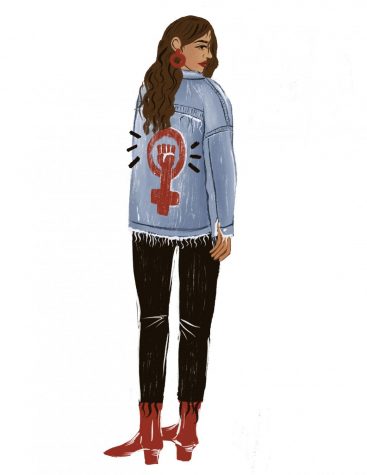From Viet Cong flags to no bra: Students use personal style to make political statements
April 26, 2019

In today’s political climate, seas of bubblegum-pink “pussy hats” and bright red “Make America Great Again” caps show political fashion is alive and on display. Students at Columbia are no exception, using their personal style to communicate their thoughts about the world around them.
“I always tell my students that fashion is a language, and whenever someone encounters [them] for the first time, [that people] are able to read who [they] are by looking at what [they] are wearing,” said Lauren Downing Peters, assistant professor in the Fashion Studies Department. “Clothing is really a remarkable means of stating [one’s] political opinions.”
At President Donald Trump’s 2019 State of the Union address, dozens of women from the House of Representatives wore white in honor of the suffragettes.
The white frocks of the 20th century suffragette movement, the white pantsuit Shirley Chisholm wore in 1969 when she became the first black woman to be elected to Congress and the berets, powder-blue shirts and black leather jackets of the 1960s Black Power Movement are a few examples of how fashion has been used to make political statements.
“Politics is one of the main driving forces behind fashion,” Peters said. “All of us are products of our generation and products of the society in which we live.”
Clothing choices and trends are indicative of the social freedoms in any given society. Any clothing choices that pose as a challenge to their viewers carry political meaning, Peters said.
Political dress at Columbia can be dated back to 1969 when class valedictorian Bert Gall—a 1969 journalism alumnus who later served as Columbia’s executive vice president from 1978–1992 and consecutively as provost from 1992–2000—wore a Viet Cong flag and rice hat at commencement to protest the Vietnam War.
Senior fiction major Jessica Powers describes her personal style as androgynous. She wears whatever she feels like on any given day to send the message that anyone can dress however they want regardless of gender.
“I’m definitely a proponent of not wearing a bra all of the time [and] not [wearing] makeup all of the time,” Powers said. “I’m not a very political person, but dressing however [one] wants to is … a political statement in and of itself.”
Freshman audio exploratory major Tim Kodner said he regularly wears anything from white faux-fur to T-shirts with their sleeves strung together with safety pins.
“When I dress, I try to express myself as an individual, and being an individual means being totally free,” Kodner said. “Even if it’s out of the ordinary, [having] some weird look that makes [one] stand out [is] helping to give society an open mind.”
By wearing what he wants, Kodner said he hopes it will make people around him feel more comfortable dressing how they want, not how society wants them to.
Freshman English exploratory major Jacob Marchioretto said he tends to gravitate toward classic staples like Adidas pants and sweatsuits.
“[We] are given the ability to stand out; [we] have the freedom to wear what [we] want,” Marchioretto said. “If [one] looks different and dresses differently, society might be more tolerant of other people dressing [in] similar ways.”







